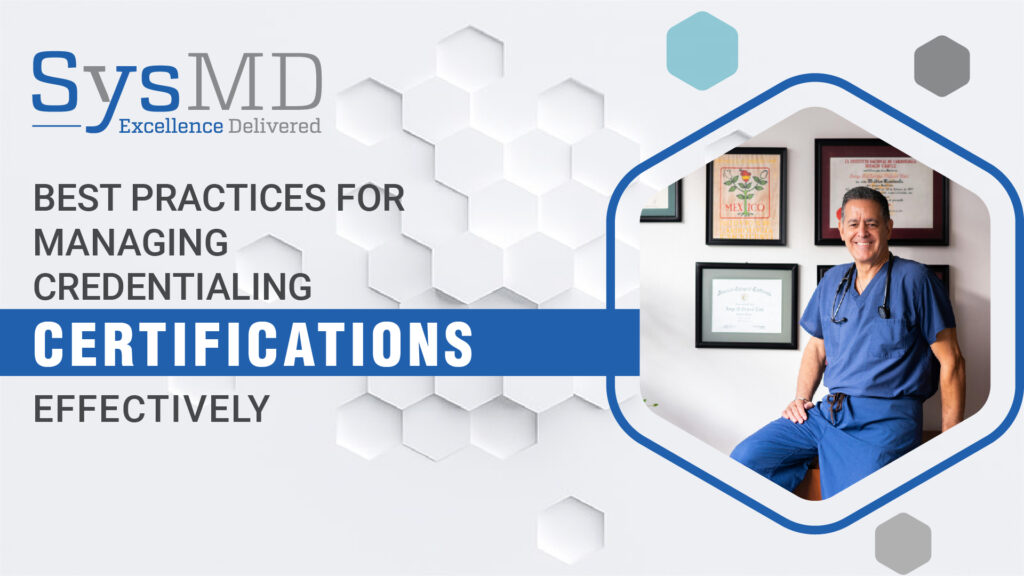Credentialing certifications in the healthcare industry are relevant to compliance, efficiency, and security. Credentialing has to do with the verification of whether or not healthcare practitioners are adherent to some level of standard before they provide care. This process is not only vital for healthcare providers but also for the healthcare organizations they work for. It can have issues for instance legal issues such as questions whose answers are in the expired or wrong credentials when dealing with patents.
Managing healthcare credentialing effectively requires a structured approach, including proper documentation management, digital solutions, and regular audits. Now it is high time to examine what you should and should not do really regarding credentialing certifications to let your healthcare organization function in the best way.
Get a Standard Credentialing Program in Places?

The first and most important step in managing healthcare credentialing certifications is to implement a standardized process. Both initial and fee-based credentialed certifications filed, managed, and assessed should have policies. This process should include:
- The policies relating to the credential process, namely the compilation, authentication, and update of the credential. Working relationships that are specially formed are to provide direction to the credentialing team members.
- Credentialed staff should have a clear calendar with dates when filing documents, when the credential verification process is to be completed, and when renewal notifications are to be sent.
- It is assumed that a standard process will not differ with different hospitals hence ruling out occurrences of mistakes. By having a formalized plan in place, healthcare organizations can streamline credentialing operations and ensure that every staff member knows their responsibilities.
Related Article: Step-by-Step Credentialing: How to Enroll Providers with Insurance Companies
Utilize Digital Tools for Documentation Management
Gone are the days when healthcare organizations relied on physical paperwork to manage credentialing certifications. With the rise of technology, healthcare organizations can now benefit from digital documentation management systems. Using digital tools for credentialing offers several advantages:
- Easy access and retrieval: Digital systems allow organizations to store and retrieve credentialing documents quickly. This is very useful especially if you deal with audit, renewal, or compliance matters.
- Automated alerts: EDMS can also have alerts on the near-expiring certifications. This reduces the chance of the following failures of presenting the right credentials making the healthcare professionals always be professional as required.
- Data security: Current digital systems offer the best encryption, which is a must for the safety of credentialing information. Healthcare organizations can limit access to authorized personnel and monitor any changes made to credentialing documents.
By switching to digital documentation management systems, healthcare organizations can save time, reduce paperwork, and enhance the security of their credentialing processes. Additionally, leveraging medical billing services can further improve operational efficiency by integrating billing and credentialing systems.
Conduct Regular Audits of Credentialing Documentation

Audits are a critical part of ensuring that healthcare credentialing is managed effectively. From time to time, some issues or irregularities require correction, or else, there are credentialing certifications, that may have expired or those with some missing documents that are required to be renewed and may require attention and vision. Here’s why audits are so important:
- Ensuring accuracy: In time they may become invalid, revoked or changed, or simply upgraded in some way. Continuity assessments ensure that all credentialing data are accurate and well-updated.
- Compliance checks: They must meet various regulatory and accreditation requirements. Audits support ensuring that the credentialing procedures are in line with standards in the marketplace and the organization is equipped to undertake any external audits.
- Identifying areas of improvement: Audits provide valuable insights into their credentialing processes. It also can define where there is an issue, an error, or improper or poor working of the system which has to be addressed.
To stay ahead, healthcare organizations should schedule periodic audits of their credentialing documentation and act on any findings immediately. Regular audits are also crucial for organizations that utilize value-added services to enhance their compliance monitoring efforts.
Ensure Proper Training and Support for Staff
Issuing or applying credentials certifications still requires the attention of another team that understands the importance of certification. Healthcare organizations should invest in training and support for staff responsible for credentialing to ensure they are well-equipped to handle the task. Training programs can include:
- Credentialing best practices: Minimizing the implementation differences between records kept and credential verifications increases the quality of staff education.
- Use of digital tools: As more organizations adopt digital credentialing systems, staff must be trained on how to use these tools effectively. It ranges from knowing how to search documents and setting an alert to carrying out an audit in the said system.
- Compliance updates: He availed his opinion to point out that in healthcare there are many regulations and that these change over time. A specific enforcement implication is to make sure that the executive and the staff are aware of new changes that happen in the credentialing requirements to make the organization watertight for an external audit per formation.
By providing ongoing training and support, healthcare organizations can enhance their credentialing processes and minimize errors. Utilizing virtual medical assistants can also provide additional support in managing credentialing tasks effectively
Establish a Clear Renewal and Expiry Tracking System
One of the biggest challenges in healthcare credentialing is keeping track of when certifications are set to expire. Effects of no renewal include lack of employment with healthcare providers, as well as penalty for the organization. This one can be avoided if there is a good tracking system that can track the certification expiry dates.
- Automated reminders: A few of the aforementioned digital tools can let the staff and credentialing teams know that some certifications will expire soon. This proactive approach helps stay ahead of deadlines.
- Centralized tracking: Having a centralized system where all credentials are stored and tracked makes it easy for healthcare organizations to monitor certification statuses in real-time.
- Delegate responsibilities: The renewal process should also have certain team members who can be dedicated strictly to the exercise of overseeing the credentialing certifications non-stop.
By staying on top of renewal and expiry dates, healthcare organizations can avoid costly penalties and ensure that their professionals are always qualified to provide care.
Also Read: Strategies to Prevent Medical Billing Mistakes: A Complete Guide
Ensure Products Security and Privacy
The credentialing documentation as well as many other correspondences in the healthcare industry involve addressing issues, to a high level of security. Healthcare organizations must prioritize the security and confidentiality of all credentialing records. Key practices for ensuring security include:
- Data encryption: Ensure all the credentialing documents are retained in systems that support data that is stored as well as data in transit.
- Restricted access: Credentialing documentation should be retained only for the reach of tops and specific persons with certain authority and certain levels of responsibilities. The use of role-based access guarantees that users are only given some information they need.
- Regular security assessments: Conducting routine security assessments helps identify vulnerabilities in their credentialing documentation systems and address them before they lead to breaches.
By prioritizing security, healthcare organizations can protect sensitive credentialing information and maintain the trust of their healthcare professionals and patients.
Conclusion
Credentialing certifications may be challenging to manage, and that is not simple to accomplish; however, provided that one has appropriate tools and capable employees to achieve it. Sysmd, a trusted medical billing company, offers tailored solutions that streamline credentialing processes for healthcare organizations. With Sysmd’s advanced documentation management systems, compliance monitoring, and regular audits, your organization can ensure accuracy, security, and efficiency in handling credentialing certifications. Furthermore, Sysmd’s services assist you to remain compliant and more to the point it assists your organization reduce time consumption hence providing your clients with the best patient care possible.


